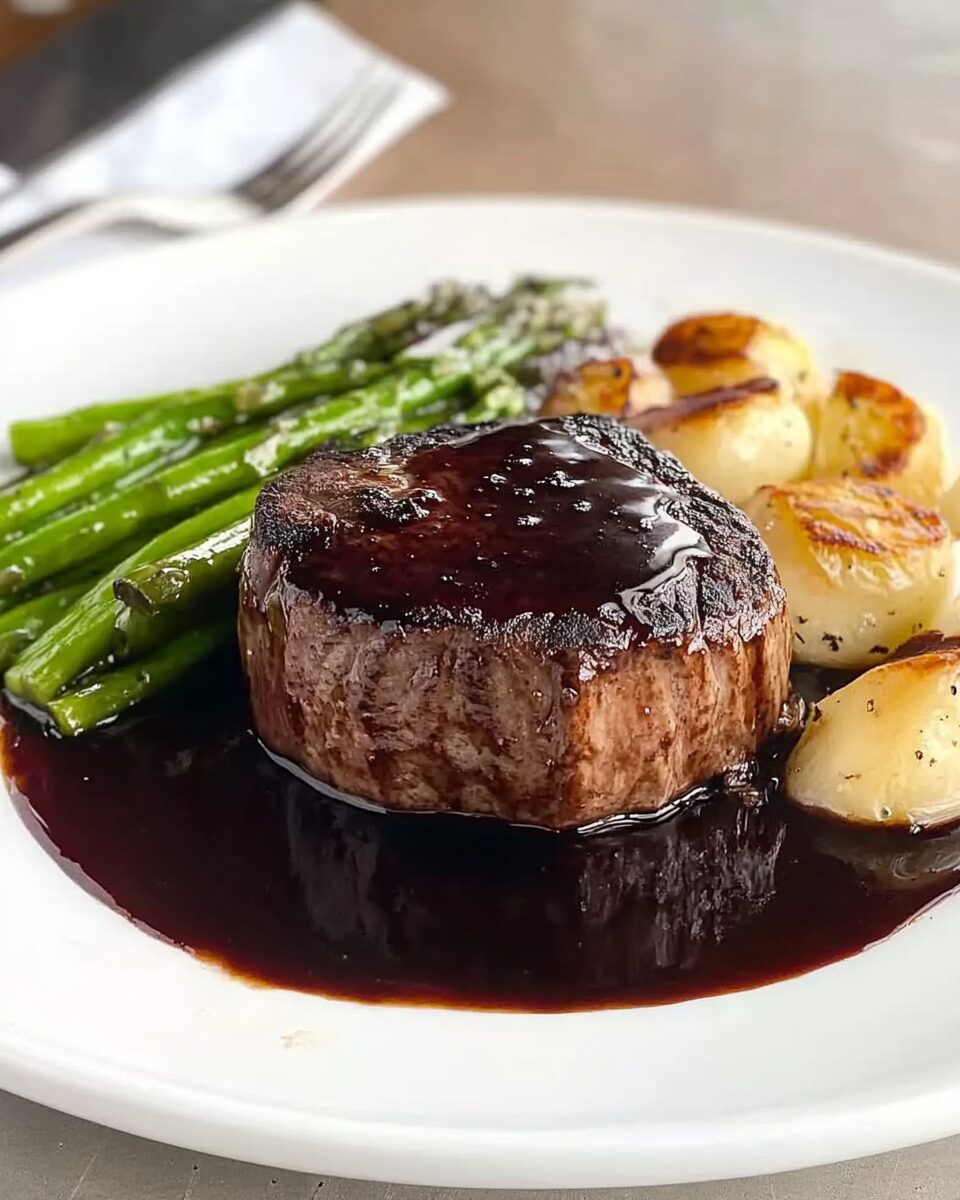Filet Mignon with a rich balsamic glaze is the ultimate indulgence for a romantic dinner or special occasion. The perfectly seared exterior encases a tender, melt-in-your-mouth interior, while the balsamic reduction adds a touch of acidity and depth that balances beautifully with the richness of the meat.
This dish is both sophisticated and simple to prepare, ideal for impressing someone special without spending hours in the kitchen. Serve with roasted potatoes or steamed asparagus to complete the meal, and don’t forget a glass of your favorite red wine to complement the flavors. It’s an elegant dining experience made right at home.
Full Recipe:
- 2 filet mignon steaks (about 6 oz each)
- 2 tablespoons olive oil
- Salt and black pepper, to taste
- 1/4 cup balsamic vinegar
- 1/4 cup dry red wine
- 1 tablespoon unsalted butter
- Fresh herbs (such as rosemary or thyme) for garnish
Directions:
- Preheat your oven to 400°F (200°C).
- Season the filet mignon steaks generously with salt and pepper on both sides.
- In a large oven-safe skillet, heat the olive oil over medium-high heat.
- Sear the steaks for about 2-3 minutes per side until browned.
- Transfer the skillet to the preheated oven and cook for an additional 5-7 minutes for medium-rare, or to desired doneness.
- Remove steaks from the skillet and cover with foil to rest.
- In the same skillet over medium heat, add balsamic vinegar and red wine. Stir, scraping up the browned bits on the bottom of the skillet, and cook for 3-4 minutes until slightly thickened.
- Stir in the butter until melted and the sauce is glossy.
- Serve the filet mignon with the balsamic glaze drizzled over the top. Garnish with fresh herbs if desired.
Prep Time: 10 minutes | Cooking Time: 15 minutes | Total Time: 25 minutes
Kcal: 350 kcal | Servings: 2 servings
Filet Mignon with Rich Balsamic Glaze: The Perfect Gourmet Dish for Special Occasions
Filet Mignon with a rich balsamic glaze is a classic, sophisticated dish that has earned its place in fine dining and home kitchens alike. This recipe combines the tender, buttery texture of filet mignon with the deep, slightly acidic complexity of a balsamic glaze, creating a meal that is not only flavorful but visually impressive. Here, we’ll dive into the origins of filet mignon, offer tips for perfect preparation, discuss flavor pairings, and suggest variations to suit different dietary preferences, making this a complete guide to mastering this elegant dish.
Origins and Popularity of Filet Mignon
Filet mignon, a term meaning “dainty filet” in French, originates from the smaller end of the tenderloin cut of beef, prized for its tenderness and mild flavor. Known as one of the most luxurious cuts, filet mignon is leaner than other beef cuts, lacking the marbling that gives ribeye its juiciness, but instead offering a smooth, buttery texture. This cut became popular in French and American cuisine in the early 20th century, where it was often served with sauces and garnishes that enhanced its subtle flavor. Today, it’s a favorite for high-end meals and celebrations, with many variations that allow home cooks to enjoy this special dish.
Selecting the Perfect Filet Mignon
Choosing a high-quality filet mignon is the first step in achieving a restaurant-worthy dish. Look for steaks that are uniformly thick, with a bright red color and minimal fat. Grass-fed beef has a slightly different flavor profile than grain-fed, often providing a slightly earthier taste that pairs well with the balsamic glaze’s acidity. Aim for filets that are 1.5 to 2 inches thick to ensure they sear beautifully and retain juiciness after cooking.
The Role of Balsamic Glaze: Depth and Balance
Balsamic glaze offers the perfect balance to filet mignon’s delicate flavor. Made by reducing balsamic vinegar, often with a hint of sugar or honey, balsamic glaze becomes thick and syrupy, with a sweet-tart taste that complements the savory notes of the beef. For added depth, red wine can be added to the reduction, creating a rich sauce that coats the filet in a glossy, dark sheen. This glaze not only enhances flavor but also adds visual appeal, making the dish look as luxurious as it tastes.
Preparing the Filet Mignon: Steps for Success
- Season Generously: Start by patting the steaks dry with a paper towel and seasoning them liberally with salt and freshly cracked black pepper. Allowing the steaks to sit at room temperature for about 15 minutes will help ensure even cooking.
- High-Heat Searing: Use a heavy skillet, ideally cast iron, to achieve a perfect sear. Preheat the skillet over medium-high heat with a bit of olive oil or clarified butter. When the skillet is very hot, add the steaks and sear them for about 2-3 minutes per side until a golden-brown crust forms.
- Oven Finish: After searing, place the skillet in a preheated oven at 400°F (200°C). Cook for an additional 5-7 minutes for medium-rare or adjust based on desired doneness. This technique, often called the reverse-sear, ensures the steaks are evenly cooked and tender.
- Resting the Steak: Let the filet mignon rest for about 5 minutes after cooking. This resting period allows the juices to redistribute throughout the meat, making each bite juicy and flavorful.
Making the Balsamic Glaze
A balsamic glaze is simple to make but adds an extraordinary flavor to filet mignon. To create a balanced glaze, use high-quality balsamic vinegar. Here’s a step-by-step guide:
- Reduce the Balsamic: In the same skillet used to cook the steaks, pour in 1/4 cup of balsamic vinegar and 1/4 cup of red wine. Heat over medium heat, stirring occasionally to incorporate any leftover browned bits.
- Simmer Until Thickened: Allow the mixture to simmer until it reduces by half, about 3-4 minutes. The glaze should become thick and syrupy. For a slightly sweeter taste, add a teaspoon of honey or a sprinkle of brown sugar.
- Add Butter for Gloss: Once reduced, stir in a tablespoon of butter to give the glaze a rich, glossy finish. This step adds a creamy texture to the glaze that pairs beautifully with the filet.
- Serve Immediately: Pour the balsamic glaze over the filet mignon or serve on the side for dipping.
Side Dishes and Pairing Suggestions
A well-chosen side dish enhances the experience of filet mignon with balsamic glaze. Consider the following pairings:
- Potatoes: Roasted baby potatoes or creamy mashed potatoes are classic accompaniments that balance the richness of the meat with a comforting starch.
- Vegetables: Asparagus, green beans, or brussels sprouts roasted with a touch of olive oil and garlic complement the balsamic glaze’s acidity.
- Salad: A simple salad with arugula, Parmesan shavings, and lemon vinaigrette adds a refreshing contrast to the rich flavors of the steak.
- Bread: Crusty bread is perfect for soaking up any remaining balsamic glaze.
Wine Pairings: Selecting the Right Red
Wine enhances the flavors of filet mignon, and the balsamic glaze’s sweet-tart profile pairs beautifully with specific reds. Here are a few suggestions:
- Cabernet Sauvignon: With bold tannins and rich fruit flavors, Cabernet is a natural choice, complementing the steak’s tender texture and the balsamic’s acidity.
- Merlot: Merlot’s softer tannins and plum notes create a balanced pairing that enhances the subtle flavors of filet mignon without overpowering them.
- Pinot Noir: For a lighter option, Pinot Noir’s earthy and berry flavors offer a delicate contrast to the rich glaze.
Flavor Variations and Modifications
Filet mignon with balsamic glaze is versatile and can be modified to suit different palates and dietary preferences:
- Mushroom Balsamic Reduction: Add sautéed mushrooms to the balsamic glaze for a hearty, umami-rich flavor that complements the mild filet.
- Herb-Infused Glaze: Incorporate fresh herbs such as rosemary or thyme into the balsamic reduction for an aromatic twist. Adding garlic or shallots also adds depth and a savory edge.
- Honey or Maple Glaze: Substitute honey or maple syrup for part of the balsamic vinegar to create a slightly sweeter glaze. This works well for those who enjoy a sweeter profile with their steak.
- Peppercorn Crust: Coat the filet mignon with a peppercorn crust before searing to add a bit of spice and texture, contrasting nicely with the glaze’s smooth finish.
- Vegan Option: Use a portobello mushroom or cauliflower steak as a substitute for filet mignon. These ingredients absorb the balsamic glaze well, making for a satisfying, plant-based alternative.
Tips for Perfecting the Recipe
Mastering filet mignon with balsamic glaze requires some attention to detail. Here are tips to ensure perfection every time:
- Use a Meat Thermometer: Filet mignon is best when cooked to medium-rare, around 130°F (54°C). Using a thermometer ensures you achieve the exact doneness without guesswork.
- Don’t Skimp on Seasoning: Because filet mignon is a lean cut, seasoning is essential to bring out its flavors. Don’t be afraid to use salt generously to help form a flavorful crust.
- Opt for High-Quality Ingredients: With a simple recipe like this, the quality of each ingredient matters. Select the best balsamic vinegar and red wine you can afford for a noticeable difference in flavor.
- Rest the Meat: Never skip the resting period after cooking. This step prevents the juices from spilling out when you cut into the steak, preserving its juiciness.
Presentation Ideas for a Gourmet Touch
Presentation plays a big role in making filet mignon with balsamic glaze feel special. Here are a few ideas for a restaurant-style presentation:
- Garnish with Fresh Herbs: A sprig of rosemary or thyme on the plate adds color and aroma.
- Layered Presentation: Serve the filet over a bed of mashed potatoes with the balsamic glaze drizzled in a circular pattern around the plate for a professional touch.
- Colorful Veggie Side: Use vibrant vegetables, like roasted carrots or green beans, to add color to the plate and create visual interest.
Wrapping Up: The Ultimate Celebration Dish
Filet Mignon with Balsamic Glaze is an excellent choice for celebrating a special occasion or enjoying a gourmet dinner at home. This dish not only showcases the tenderness of the filet but also highlights the glaze’s rich, complex flavors. Whether you’re preparing it for a date night, an anniversary, or a holiday meal, this recipe guarantees a memorable dining experience.
Conclusion
Filet mignon with balsamic glaze combines elegance with simplicity. By choosing quality ingredients and following thoughtful techniques, you can recreate a steakhouse experience in your kitchen. With endless variations and pairing options, this recipe invites creativity while delivering classic flavors. From its origins in French cuisine to its beloved status in home kitchens today, filet mignon remains an icon of fine dining—elevated even further by a luscious balsamic glaze that adds depth, flavor, and an impressive finishing touch.

